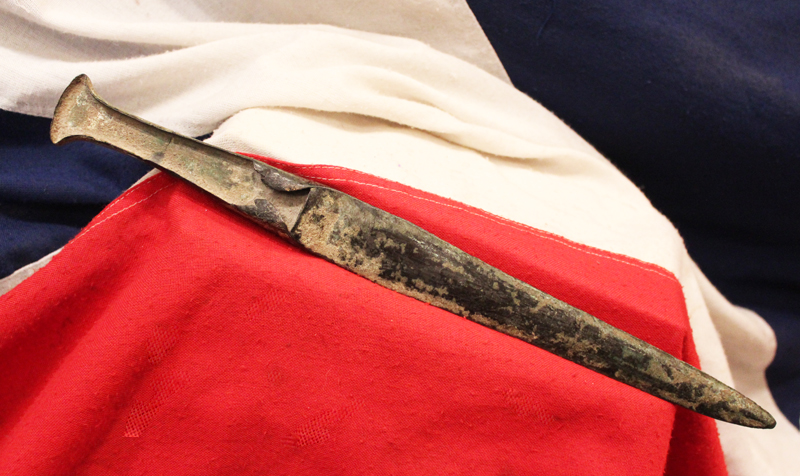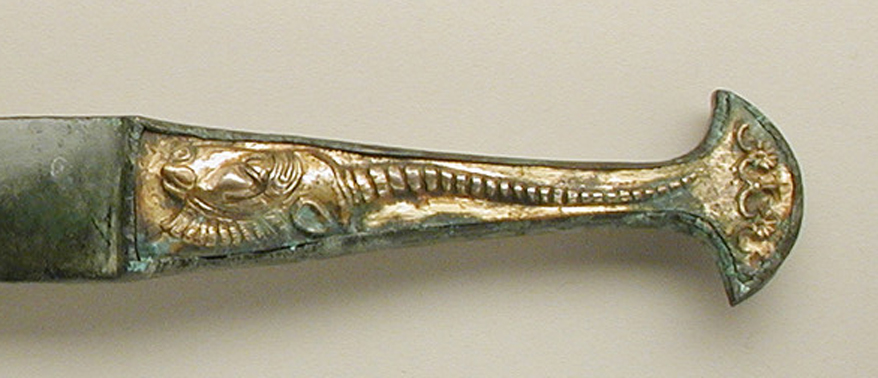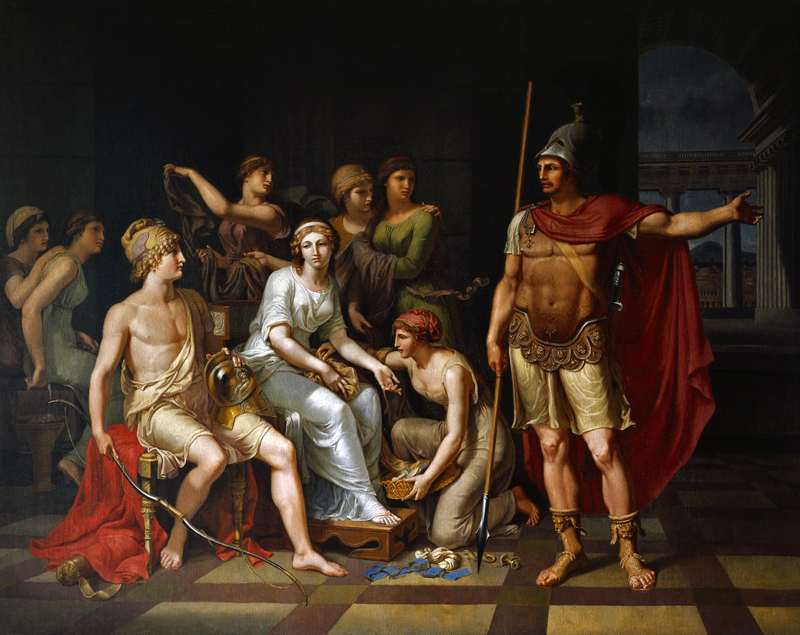An Original & Beautiful Ancient & Archaic Warrior's Dagger of the Trojan Wars Era. A Bronze Long Dagger Circa 1200 bc Around 3200 Years Old, in Superb Condition With All Its Original Age Patination Intact
This is a most handsome ancient bronze long dagger from one of the most fascinating eras in ancient world history, the era of the so called Trojan Wars. A most similar dagger, but with its gold hilt panel intact, made from 1000 to1350bc, is on display in the Los Angeles County Museum of Art, a gift of The Ahmanson Foundation. We show their dagger and its hilt with gold inlay, as the last two photos in the gallery.
The ancient Greeks believed the Trojan War was a historical event that had taken place in the 13th or 12th century BC, and believed that Troy was located in modern day Turkey near the Dardanelles. In Greek mythology, the Trojan War was waged against the city of Troy by the Achaeans (Greeks) after Paris of Troy took Helen from her husband Menelaus, the king of Sparta.
The war is among the most important events in Greek mythology and was narrated in many works of Greek literature, including Homer's Iliad and the Odyssey . "The Iliad" relates a part of the last year of the siege of Troy, while the Odyssey describes the journey home of Odysseus, one of the Achaean leaders. Other parts of the war were told in a cycle of epic poems, which has only survived in fragments. Episodes from the war provided material for Greek tragedy and other works of Greek literature, and for Roman poets such as Virgil and Ovid.
The war originated from a quarrel between the goddesses Athena, Hera, and Aphrodite, after Eris, the goddess of strife and discord, gave them a golden apple, sometimes known as the Apple of Discord, marked "for the fairest". Zeus sent the goddesses to Paris, who judged that Aphrodite, as the "fairest", should receive the apple. In exchange, Aphrodite made Helen, the most beautiful of all women and wife of Menelaus, fall in love with Paris, who took her to Troy. Agamemnon, king of Mycenae and the brother of Helen's husband Menelaus, led an expedition of Achaean troops to Troy and besieged the city for ten years due to Paris' insult. After the deaths of many heroes, including the Achaeans Achilles and Ajax, and the Trojans Hector and Paris, the city fell to the ruse of the Trojan Horse. The Achaeans slaughtered the Trojans (except for some of the women and children whom they kept or sold as slaves) and desecrated the temples, thus earning the gods' wrath. Few of the Achaeans returned safely to their homes and many founded colonies in distant shores. The Romans later traced their origin to Aeneas, one of the Trojans, who was said to have led the surviving Trojans to modern day Italy.
This dagger comes from that that great historical period, from the time of the birth of known recorded history, and the formation of great empires, the cradle of civilization, known as The Mycenaean Age, of 1600 BC to 1100 BC. Known as the Bronze Age, it started even centuries before the time of Herodotus, who was known throught the world as the father of history. Mycenae is an archaeological site in Greece from which the name Mycenaean Age is derived. The Mycenae site is located in the Peloponnese of Southern Greece. The remains of a Mycenaean palace were found at this site, accounting for its importance. Other notable sites during the Mycenaean Age include Athens, Thebes, Pylos and Tiryns.
According to Homer, the Mycenaean civilization is dedicated to King Agamemnon who led the Greeks in the Trojan War. The palace found at Mycenae matches Homer's description of Agamemnon's residence. The amount and quality of possessions found at the graves at the site provide an insight to the affluence and prosperity of the Mycenaean civilization. Prior to the Mycenaean's ascendancy in Greece, the Minoan culture was dominant. However, the Mycenaeans defeated the Minoans, acquiring the city of Troy in the process. In the greatest collections of the bronze age there are daggers exactly as this beautiful example. In the Metropolitan Museum of Art is the bronze sword of King Adad-nirari I, a unique example from the palace of one of the early kings of the period (14th-13th century BC) during which Assyria first began to play a prominent part in Mesopotamian history. Swords and daggers from this era were made in the Persian bronze industry, which was also influenced by Mesopotamia. Luristan, near the western border of Persia, it is the source of many bronzes, such as this dagger, that have been dated from 1500 to 500 BC and include chariot or harness fittings, rein rings, elaborate horse bits, and various decorative rings, as well as weapons, personal ornaments, different types of cult objects, and a number of household vessels.
An edged weapon found in the palace of Mallia and dated to the Middle Minoan period (2000-1600 BC), is an example of the extraordinary skill of the Cretan metalworker in casting bronze. The hilt of the weapon is of gold-plated ivory and crystal. A dagger blade found in the Lasithi plain, dating about 1800 BC (Metropolitan Museum of Art), is the earliest known predecessor of ornamented dagger blades from Mycenae. It is engraved with two spirited scenes: a fight between two bulls and a man spearing a boar. Somewhat later (c. 1400 BC) are a series of splendid blades from mainland Greece, which must be attributed to Cretan craftsmen, with ornament in relief, incised, or inlaid with varicoloured metals, gold, silver, and niello. The most elaborate inlays--pictures of men hunting lions and of cats hunting birds--are on daggers from the shaft graves of Mycenae, Nilotic scenes showing Egyptian influence. The bronze was oxidized to a blackish-brown tint; the gold inlays were hammered in and polished and the details then engraved on them. The gold was in two colours, a deeper red being obtained by an admixture of copper; and there was a sparing use of neillo. The copper and gold most likely came from the early mine centres, in and around Mesopotamia, see gallery and the copper ingots exported to the Cretans for their master weapon makers. This dagger is in very nice condition with a single fracture one one side of the hilt 14.75 inches long overall.
Code: 20797
1395.00 GBP










